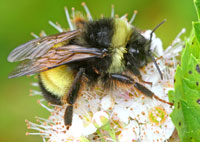Yellow-banded Bumble Bee
Scientific name: Bombus terricola

Cover photo credit: © Denis Doucet CC BY-NC
Status
Special Concern
“Special Concern” means the species lives in the wild in Ontario, is not endangered or threatened, but may become threatened or endangered due to a combination of biological characteristics and identified threats.
Date added to the Species at Risk in Ontario List
June 15, 2016
Read the assessment report (PDF)
What it looks like
The Yellow-banded Bumble Bee is a medium-sized bumble bee with a distinct yellow and black abdominal band pattern found on its queens, males, and workers.
It has a short tongue relative to other bumble bee species and will compete with other bees for food pollen and nectar. It is also known to “nectar-rob” by reaching nectar through holes bitten in the base of the flower.
Where it lives
This species is a forage and habitat generalist, able to use a variety of nectaring plants and environmental conditions.
The Yellow-banded Bumble Bee has a large range throughout much of Canada and parts of the United States. It can be found in mixed woodlands, particularly for nesting and overwintering, as well as a variety of open habitat such as native grasslands, farmlands and urban areas.
Nest sites are often underground in abandoned rodent burrows or decomposing logs.
Where it’s been found in Ontario
The Yellow-banded Bumble Bee ranges from the Mixedwood Plains of southern Ontario to the Hudson Bay Lowlands in the north.
In southern Ontario, it is still observed but is less common than it was historically after steep declines. Less is known about historical or recent abundance of Yellow-banded Bumble Bee in the northern portion of its range.
What threatens it
Causes of decline of this once common species are only partially understood.
Suspected threats to the Yellow-banded Bumble Bee include a combination of factors such as the introduction of pathogens from managed bee colonies, pesticide use, climate change, and habitat loss.
Action we are taking
The Government of Ontario is working with stakeholders, the public, and other levels of government to develop strategies and plans to address the main stressors that pollinators face and to enhance the health of Ontario’s pollinators and to strengthen their populations.
Special concern species do not receive species or habitat protection.
What you can do
Report a sighting
- The Ministry of Natural Resources and Forestry tracks species at risk such as the Yellow-banded Bumble Bee. You can use a handy online form to report your sightings to the Natural Heritage Information Centre. Photographs with specific locations or mapping coordinates are always helpful.
Volunteer
- Volunteer with your local nature club or provincial park to participate in surveys or stewardship work focused on species at risk.
- Consider joining existing citizen science projects to contribute to a ‘virtual’ bumble bee collection, help researchers or connect with others interested in bumble bee conservation efforts.
Be a good steward
- Private land owners have a very important role to play in species recovery; if you find the Yellow-banded Bumble Bee on your land, you may be eligible for stewardship programs that support the protection and recovery of species at risk and their habitats.
- The Canada-Ontario Farm Stewardship Program is available to eligible farmers to encourage greater protection and conservation of habitat for species at risk. Find more information.
- Learn more about conserving pollinators from the North American Pollinator Protection Campaign.
- Plant a variety of native flowering plants that bloom from early spring to late fall to help provide constant nectar and pollen throughout the growing season.
- Dandelion flowers are one of the few sources of nectar and pollen for queen bumble bees emerging from hibernation in the spring; consider waiting until other flowers are abundant before mowing your dandelions. Also, leave areas of bare ground, including old rodent burrows, so bumble bees can dig nests. When you help bees live on your land, they help you by pollinating your flowers (e.g., tomato flowers, cherry blossoms).
Report illegal activity
- Report any illegal activity related to plants and wildlife to
1-877-TIP-SMNR (847-7667) .
Quick facts
- Emerging in early spring, the Yellow-banded Bumble Bee is likely an important pollinator of early blooming wild flowering plants such as wild blueberry as well as agricultural crops such as apples, cranberry and alfalfa.
- The Yellow-banded Bumble Bee is closely related to and shares ecological traits with the Rusty-patched Bumble Bee, an endangered species in Ontario and Canada.
- Vacated cocoons may be used by this species to store pollen to feed larvae.
- Bumble bees such as the Yellow-banded Bumble Bee thermoregulate, a rare capability among insects. Bumble bees accomplish this by shivering to generate heat in their thoracic muscles.